Key Points:
- The Brazos River is a notoriously polluted river, with a cocktail of toxic waste products in it. It also is home to a brain-eating amoeba; if infected with this parasite, the victim can contract Primary Amoebic Meningoencephalitis. This disease has a 97% mortality rate.
- The American alligator and blue catfish are two species that can commonly be found in this river.
- Largemouth bass live in this river, but are generally considered an invasive species.
Also known as the Rio de los Brazos de Dios, the Brazos River is a waterway in central Texas. In Spanish, the river’s name translates to the “River of the Arms of God.” No one knows exactly how the river got its name. One story claims that the river got its name from Spanish explorer Francisco Vazquez de Coronado. Coronado and his men journeyed into Texas in search of the Seven Cities of Gold. When he and his men were about to die of thirst, local tribes guided them to a stream, which they named Brazos de Dios after its life-saving water.
Another tale tells a similar story of a Spanish ship that lost its way in the Gulf of Mexico. The ship ran out of drinking water and desperately searched for land. Luckily, they spotted the mouth of the Brazos River, and, upon replenishing their supplies, christened the river.
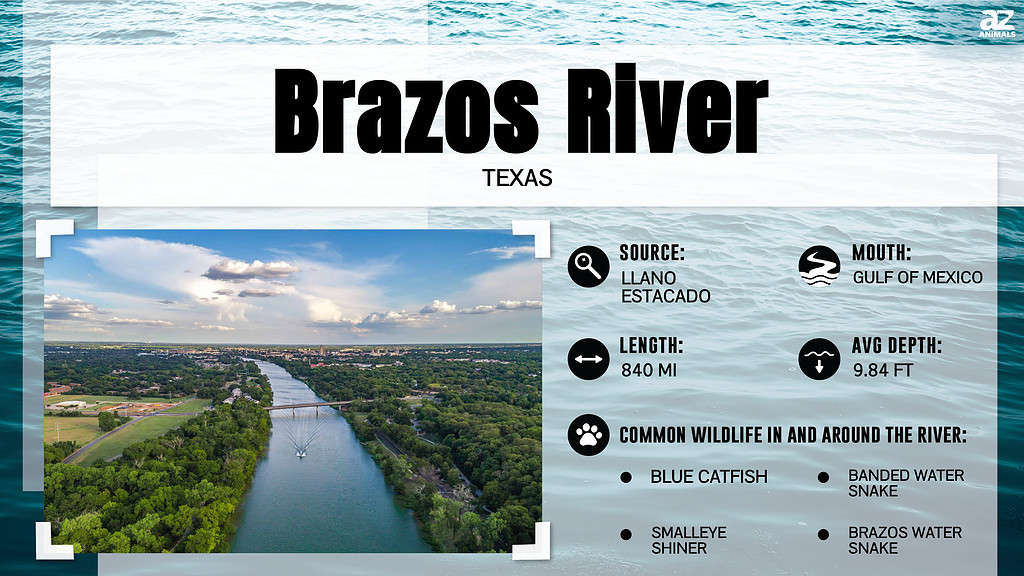
Today, most Texans identify the river as the unofficial boundary separating east and west Texas. In terms of economic importance, the river provides irrigation, power generation, and recreational opportunities for central Texas. Popular recreational activities along the river include canoeing, camping, fishing, and hunting. All that said, what sort of animals can you find living in the murky waters of the Brazos River? Keep reading to find out!
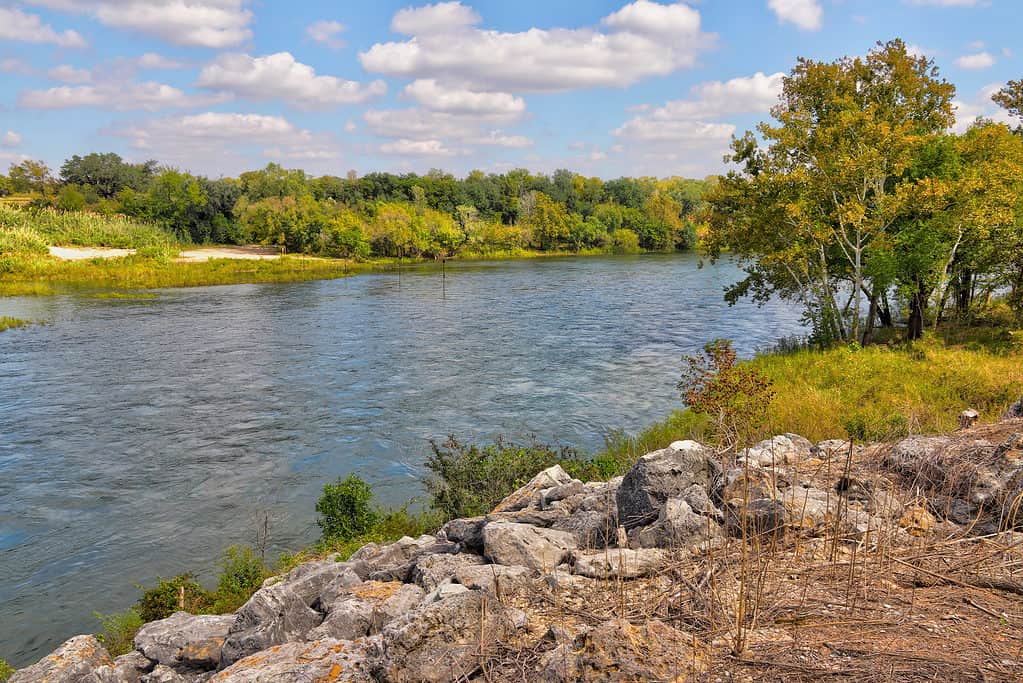
The Brazos River is a waterway known as the unofficial boundary separating east and west Texas.
©iStock.com/Hudley_Photography
About the Brazos River
The Brazos River proper starts at the confluence of two tributaries: the Double Mountain Fork and the Salk Fork. The Salt Fork begins along the Llano Estacado, or Stake Plains, around 2 miles southwest of Cap Rock, Texas. As for the Double Mountain, its origins also begin on the Llano Estacado around 11.5 miles southeast of Tahoka, Texas. That said, numerous other tributaries flow into the Brazos River. Some of its most critical tributaries include the Clear Fork Brazos River, the Paluxy River, the Little River, the Bosque River, the Nolan River, and the Leon River.
The main stem of the Brazos River runs southeast for approximately 840 miles, making it the 14th longest river in the United States. However, its headwaters technically begin further upstream at the head of Blackwater Draw, an intermittent stream channel in Roosevelt County, New Mexico. When you include these waters, the full length of the Brazos River equals 1,280 miles. The main stem of the river passes through several major metro areas, including Waco and Houston, before it empties into the Gulf of Mexico.
Throughout history, the Brazos River has played an important role in the development of the region. Several Native American tribes lived within and around the Brazos River Valley, including the Comanche, Wichita, Tonkawa, and Karankawa. During the early nineteenth century, the Brazos River Valley served as the site for one of the first settlements in Texas. In 1836, Texas officially declared its independence from Mexico at Washington-on-the-Brazos in modern-day Washington County. During the Texas Revolution, several naval battles took place along the river. The river also acted as a vital means of navigation for troops and supplies during the American Civil War.
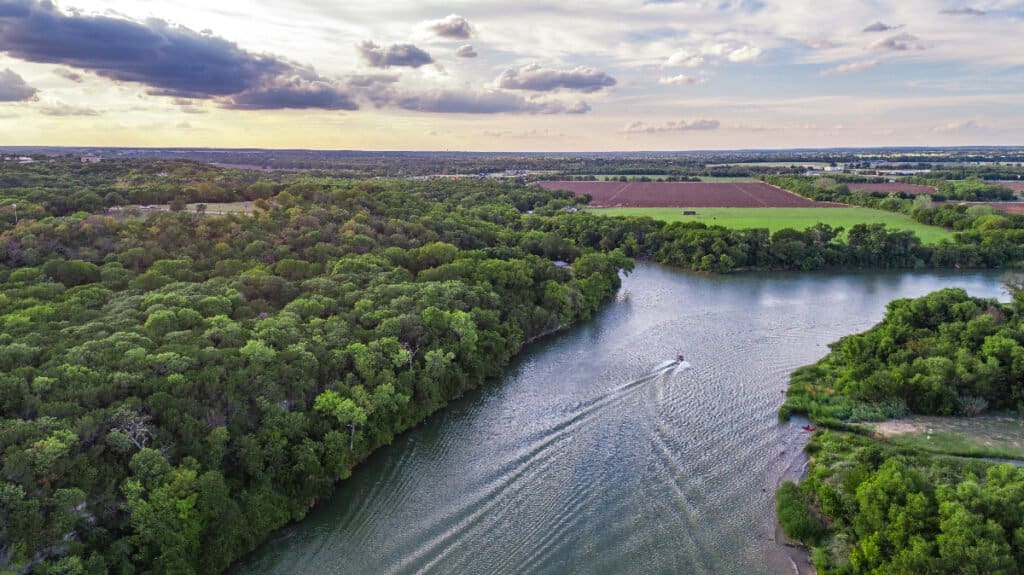
The Brazos River passes through major metro areas, including Waco and Houston, before emptying into the Gulf of Mexico.
©davisdeatonphotography/Shutterstock.com
Is the Brazos River Dangerous?
The main safety issues concerning the Brazos River all focus on water quality. The Brazos River watershed contains high nutrient loads, as well as high saline and bacterial levels. Simultaneously, the watershed also features low levels of dissolved oxygen. These problems stem from the large quantities of fertilizer, chemicals, and animal waste that flow into the river via groundwater runoff. This potent cocktail of toxic waste gets particularly bad the further you travel downstream. In fact, in 2012 alone, the Brazos River received nearly 33.4 million pounds of toxic chemicals. Today, Texas ranks top two in the nation when it comes to the worst public water ratings.
The Brazos River is also home to one of the most infamous and dangerous bacteria in the United States. Known as the brain-eating amoeba, Naegleria fowleri can cause Primary Amoebic Meningoencephalitis or PAM. PAM attacks the host’s central nervous systems, and infected individuals have a whopping 97% mortality rate. According to the CDC, 151 documented PAM cases occurred between 1962 and 2020, 39 of which occurred in Texas. Most cases occur in rivers, lakes, or streams with high levels of pollution, like the Brazos River. Infection risk spikes in the summer as Naegleria fowleri thrives in warmer water.
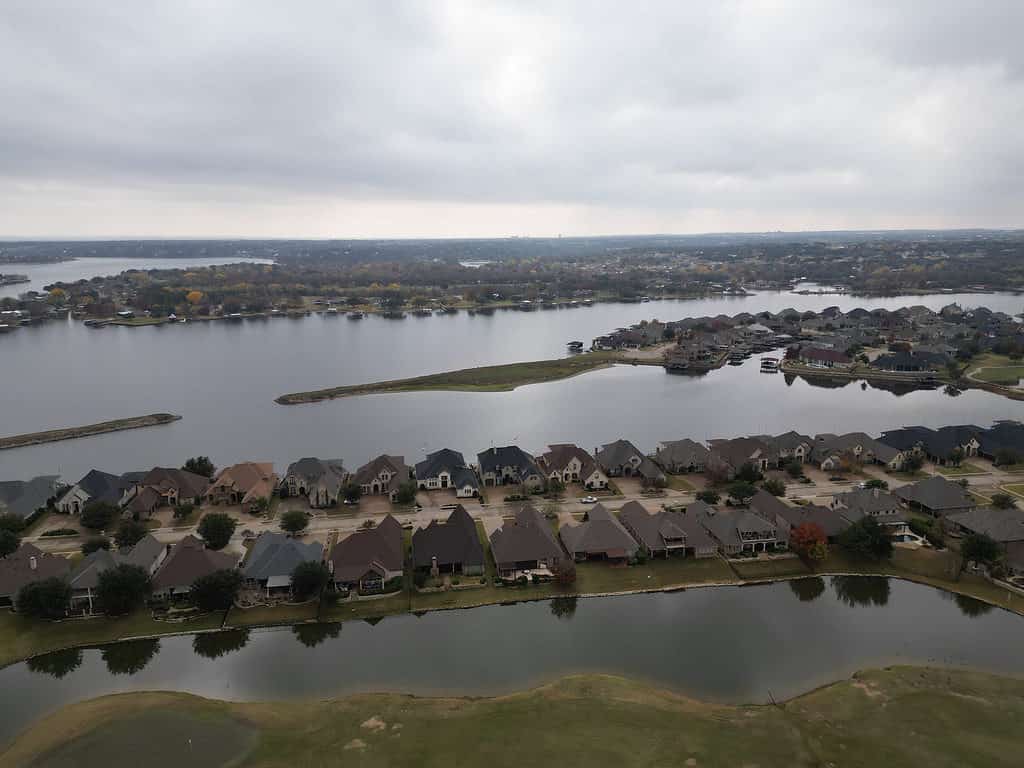
The Brazos River’s safety issues focus on water quality impacted by high nutrient loads, saline and bacterial levels.
©iStock.com/Wirestock
What Lives at the Bottom of the Brazos River?
The Brazos River watershed supports a diverse array of flora and fauna. Approximately 42 rivers and lakes lie within the watershed, which covers around 46,000 square miles. Grassland comprises most of the land within the watershed at 61%, followed by shrubland at 19.8% and forest at 11%. Animal inhabits along the Brazos River include bobcats, foxes, white-tailed deer, and feral hogs. Meanwhile, the river itself supports various species, including catfish, crappie, and other fish species. Let’s take a deeper look at what lives at the bottom of the Brazos River.
American Alligator
Also known simply as the gator or common alligator, the American alligator is the second-largest reptile native to the United States. Adult alligators range between 8.5 and 15.1 feet long, with males generally measuring longer than females. Although most specimens weigh up to 999 pounds, some reports claim to have found alligators weighing more than 2,000 pounds. American alligators possess dark-colored scales, broad snouts, and large, overlapping jaws. These apex predators eat a wide variety of prey, including birds, fish, mammals, and other reptiles. Overhunting almost led to the extirpation of American alligators throughout much of the United States in the mid-20th century. Thanks to aggressive conservation efforts, the species slowly recovered from an Endangered species to a species of Least Concern.

American alligators, which can grow between 8.5 and 15.1 feet long, can be found on the Brazos River.
©iStock.com/Cindy Larson
Blue Catfish
The blue catfish, Ictalurus furcatus, belongs to the catfish family Ictaluridae. These massive fish ranks as the largest catfish species found in North America. Exceptionally large specimens can grow up to 150 pounds and 65 inches long. As their name implies, blue catfish have blueish-gray, heavy bodies, and a distinctive dorsal hump. Blue catfish are opportunistic carnivores that eat whatever they can catch, including mussels, frogs, crayfish, and other fish. Anglers prize blue catfish for their large size. As a result, they have spread or been introduced to many waterways throughout the United States. In some regions, people consider them invasive pests because they can outcompete or eat native fish.

The blue catfish is the largest species of catfish in North America.
©Billy Ogle/Flickr – License
Brazos Water Snake
The Brazos water snake, Nerodia harteri, also goes by the name Harter’s water snake. The snake’s specific name honors Phillip Harter, an amateur herpetologist who first identified the snake in 1936. This non-venomous, mostly aquatic snake is endemic to Texas and found almost exclusively along the Brazos River. Most specimens measure between 16 and 32 inches long. They come in a variety of colors; the dorsal side ranges from olive green to brown, while the underside looks orange or pink. No matter the base color, every Brazos water snake features two rows of dark spots down its back and underside. Brazos water snakes prey on small fish, salamanders, crayfish, and frogs. Due to its small population and habitat, the IUCN lists the Brazos water snake as a Near Threatened species.
Largemouth Bass
The largemouth bass (Micropterus salmoides) belongs to the sunfish family Centrarchidae. While native to central and eastern North America, this immensely popular gamefish has been introduced in many waterways throughout the world. As a result, many places consider the largemouth bass an invasive species due to its ability to outcompete native species. Largemouth bass possess greenish-gray to olive-green scales and feature black blotches down each side. They sport a characteristic underbite, hence the name largemouth. The biggest largemouth bass on record measured 29.5 inches long and weighed 25 pounds, 1 ounce. These predatory fish eat a diverse array of prey, including insects, shrimp, frogs, salamanders, snakes, bats, and other fish. Anglers love fishing for largemouth bass due to their impressive size and tendency to “fight.”
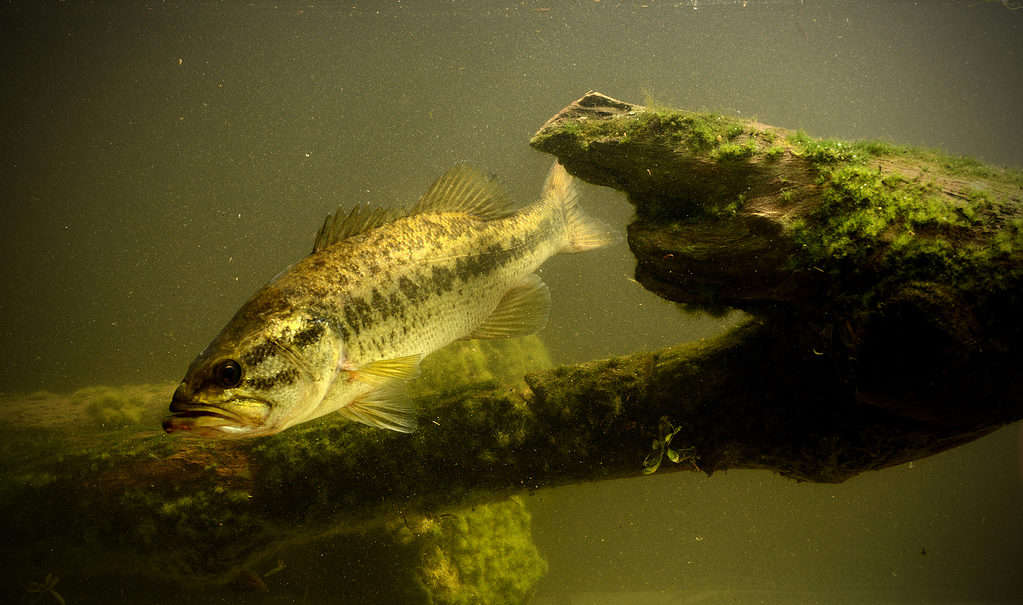
Largemouth bass possess greenish-gray to olive-green scales and feature black blotches down each side.
©iStock.com/FtLaudGirl
Alligator Snapping Turtle
Macrochelys temminckii is better known as the alligator snapping turtle. A member of the family Chelydridae, the alligator snapping turtle ranks as one of the largest freshwater turtles in the world. Specimens usually range between 12.8 and 31.8 inches long and weigh from 19 to 176 pounds, with males generally measuring larger than females. That said, especially large specimens can exceed 200 pounds. Alligator snapping turtles possess large, powerful jaws capable of producing pressure equal to 1,000 psi. These opportunistic carnivores eat both live prey and scavenge for carrion. While they primarily eat fish, they may also feed on birds, other turtles, and even small alligators. In captivity, they typically live between 20 and 70 years, but their potential lifespan could reach 120 years old. Alligator snapping turtles face numerous threats, including habitat loss, hunting, and the pet trade. The IUCN lists it as a Vulnerable species.

Alligator snapping turtles possess large, powerful jaws capable of producing pressure equal to 1,000 psi.
©iStock.com/Sista Vongjintanaruks
Interesting Facts
- The Brazos River ranks as the 14th longest river in the United States.
- Three dams and nineteen major reservoirs are located along the main stem of the Brazos River.
- In Spanish, the Brazos River’s name translates to “River of the Arms of God.”
- One of the first English-speaking colonies in Texas was built along the Brazos River and founded by Stephen F. Austin, the “Father of Texas” and its fourth Secretary of State.
- Popular activities along the Brazos River include canoeing, camping, and fishing.
The photo featured at the top of this post is © davisdeatonphotography/Shutterstock.com
Thank you for reading! Have some feedback for us? Contact the AZ Animals editorial team.






